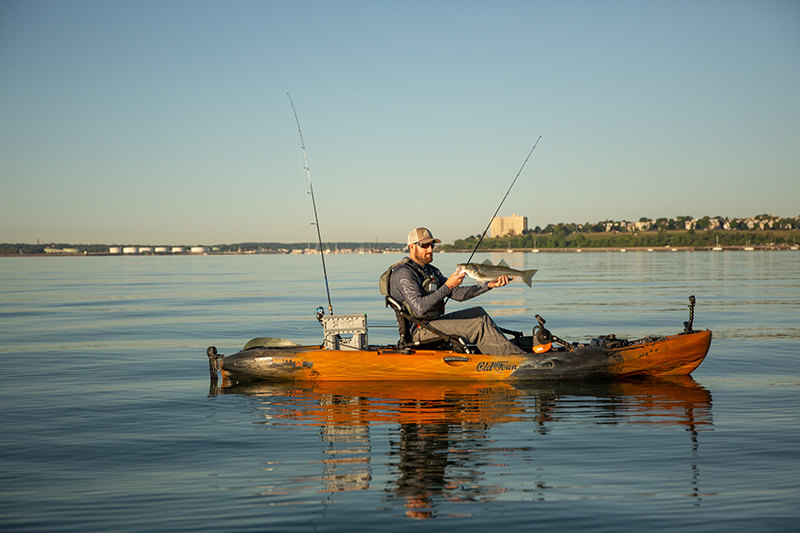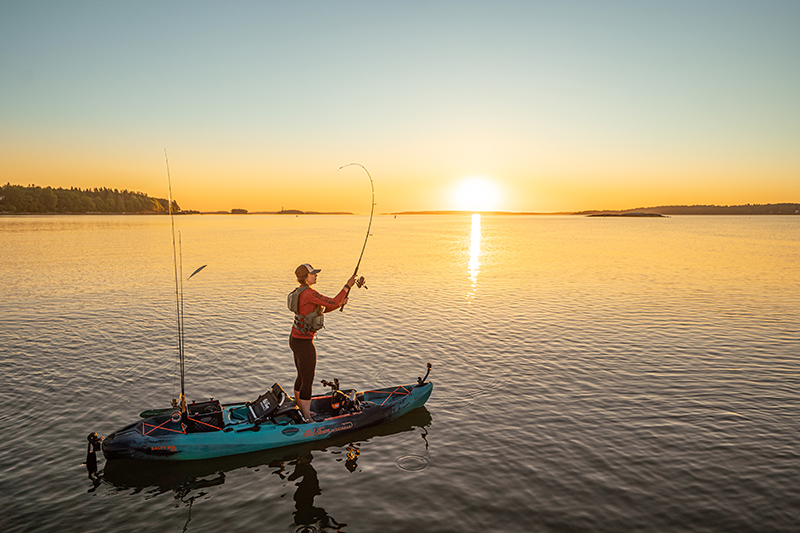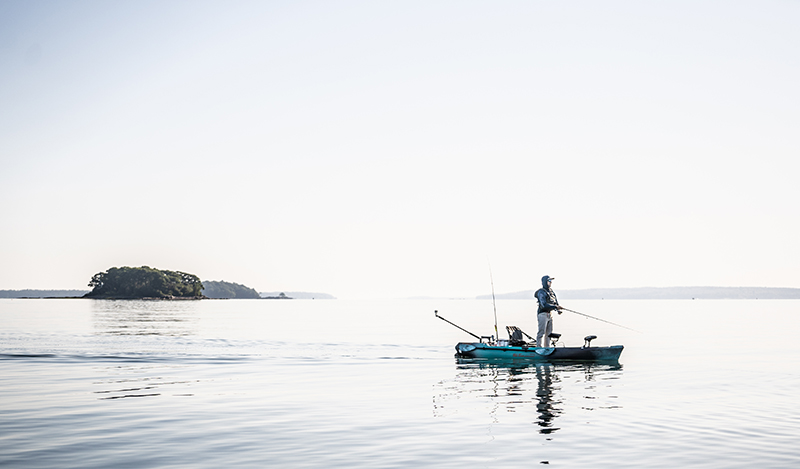A Beginner's Guide To Inshore Kayak Fishing
By: Matt Stone
I vividly remember my first time landing a saltwater fish from the kayak. It was an industrial creek in the Chesapeake Bay, a breezy autumn morning on a 9' flat next to a channel edge, and the chunky striper smacked a 4" swimbait in a bunker color. While I'd been kayak fishing for nearly a decade at that point, I understand now that the tug I felt on the end of the rod that morning was more than just a fish, it was a force of impressive power drawing me into the world of inshore saltwater kayak fishing. Since then, I've never looked back. If you haven't tried it yet, consider this a formal invitation to join the ranks of saltwater kayak anglers.
To me, there's nothing more exciting than kayak fishing the inshore saltwater scene, especially in diverse waters. When the line snaps tight and the hook is set, your first thought is probably an immediate, "This is awesome!" followed quickly by, "What's on the other end of my line?" Maybe it's a striper, blue, mackerel, or fluke; for southern folks it could be a speckled trout, redfish, or jack crevalle, and west coast anglers perhaps it's a calico bass or a sheepshead? No matter the answer, you're going to fight this fish in the best way possible - from the kayak!
The sea has that threateningly mysterious unknown, a massive galactic openness which has always drawn us to explore it. That respectful awe is what keeps me coming back for more. If you're just getting into the inshore game, you are lucky: there has never been a better time to become acquainted with the sublime awesomeness of saltwater kayak fishing. This brings me to my first message: welcome to your new obsession.
This beginner's guide can serve as a getting started checklist when expanding your kayak fishing to the salty stuff. The information here isn't exhaustive, but will provide at least enough detail to safely hit the water and catch some fish!

INSHORE KAYAK FISHING SAFETY
A long time ago when surfing on Maui, I got absolutely destroyed by a huge wave, tumbled head over heels, raked across the coral, and in the process learned one lesson about the water that I will never forget: If you don't respect the power of the ocean, you will pay the price. This thought should be front and center when preparing to kayak fish the salt for the first time. Both the beauty and danger of our awesome plastic boats is due to their simplicity. They're all we've got, and things can change in a hurry out there. For all of the technology and forecasting data available these days, there are still times when things go haywire, and you need to be prepared. This leads to another one of my favorite mantras: Everything is fine...until it isn't...then it's not! This phrase highlights the thin line between having a memorable day battling fish and a terrifying day. To ensure a memorable trip for all of the right reasons, your safety precautions should begin before putting hull to water.
LIFE JACKETS
Wear one. All the time, every single time. There's no excuse. All PFDs can save your life, and the high-end ones out now (like the Old Town Lure Angler) come with storage and features to make your day both safe and comfortable.
WEATHER
Plan your day around the weather, primarily the wind. Use Windy, Windfinder, FishWeather, or another trusted app to ensure the forecasted wind isn't going to cause trouble. For me, anything under 10mph is a green light regardless of direction, from 10-20mph I will likely plan to launch near a protected shoreline (such as the west side of a bay to hide from a west wind), and anything 20mph or over is a red light unless I really know the area and can be confident I'll be in protected waters.
Along with wind, pay attention to the tide, because they impact each other. In my home waters on the Long Island Sound, an outgoing tide travels west to east, so if I have an outgoing tide traveling to the east and, say, a 15mph wind coming from the east, well, that's a recipe for a sloppy washing machine of waves and tide ruining my day and likely making it unsafe. As someone who's new to the salt, never overestimate your abilities and always give the ocean the benefit of the doubt. Maybe you're physically fit, but you're also out there fishing, and there's a big difference between kayaking in sloppy conditions and having the wherewithal to stay stable while fighting, landing, unhooking, and releasing a fish. One wave from a weird direction while you're distracted is all it takes to create a dangerous situation.
When planning where to launch, take note of spots to beach yourself if it gets bad. Look at maps, understand the forecast, and be ready for the unexpected. If a summer thunderstorm rears its head, you better know exactly where to go if the launch is too far away.
WATER TEMPERATURE
If you fish in areas that get a decent winter, and still want to be on open water, I strongly recommend a dry suit to go with your PFD. Dry suits are waterproof suits that make you look like a seriously awesome fighter pilot, and they can also save your life. To help determine whether or not to wear one, use the 120 Rule. The 120 Rule says that if the air and water temperature added together don't reach 120, either wear a dry suit and a PFD or don't go out. It's that simple.
VHF RADIO
When out on the water, you're all you've got, so bring supplies and equip your vessel properly. For all vessels, this includes bringing a waterproof VHF radio for distress calls, weather warnings, and general communication. Most come with 25 channels, but Channels 9 and 16 are the most important. Channel 9 was established as a way to communicate with recreational vessels, and Channel 16 is the international distress, safety, and calling channel. I keep my VHF tuned to Channel 16 when kayak fishing. It's an added layer of safety, and occasionally there are interesting conversations to be heard as well. Last summer, I heard a submarine out of Groton, Connecticut communicating with fishing boats about navigation plans. Cool stuff!
OTHER SAFETY SUPPLIES
- A signaling device such as an air horn or whistle which will warn boats if you fear a collision.
- A flag for visibility. Many companies sell these and they're easy to install.
- A hand pump in case the kayak takes on water. A big sponge works too.
- A basic first-aid kit.
- If fishing between sunset and sunrise, you should have a 360 degree white light to signal your presence. If you're out later than anticipated and don't have your 360 white light, use your phone's camera light as a temporary substitute.
A final word on safety: When possible, paddle with a friend, and always tell someone where you're going, how long you expect to be out, and at what time they should contact authorities if you're not back yet. Fishing buddies are also crucial for epic photos of big catches!

INSHORE KAYAK FISHING GEAR
Speaking of big catches, let's talk about the fun part: fishing! One of the best aspects of saltwater fishing is the variety of catchable species. In New England where I fish it's not unheard of to catch over a half dozen species in one day. But that can only happen if you've got the gear. I'm not going to go into rod, reel, and lure details here, but any true angler knows there's no such thing as too many rods and reels, so suffice to say that I recommend bringing a few different setups so you've got options if one target species doesn't pan out.
Once your rods are all tied up, you'll want a few more essentials close by. These include:
- A net, preferably with rubber mesh. The rubber keeps the fish safe and tangled hooks come out of the rubber mesh much easier than a standard netting material.
- A set of corrosion-resistant pliers. Rinse them each trip and spray them down with lubricant every now and then so they stay rust-free. Built in line-cutters are a plus.
- A pair of lip-grippers. Catching toothy critters is part of the game in the salt, and it'll only take one tango with some sharp chompers to remind you of the need for lip grips.
- A knife. Things happen out there, and a knife is my safety blanket. It'll come in handy for so much: cutting line, chopping bait, dispatching a fish to bleed it out before it becomes dinner...the possibilities are endless.
- A pair of polarized sunglasses. You'll be amazed at how much of a difference these make when looking under the water. Not only that, but they're good for your eyes. The hot sun reflecting off the water all day can eventually damage your eyes. When I first got started kayak fishing, it took more killer headaches than I care to admit before I realized a good pair of shades was the missing piece of the puzzle.
There are lots of opinions out there about what gear is crucial when kayak fishing, and you'll probably end up with more on board than just these items. Accessorizing is part of the fun, and each angler is unique. Poke around and see what fits...selfie-stick anyone?
INSHORE FISHING KAYAKS
Not every fishing kayak is suited for inshore environments. The best inshore kayaks will have the hull characteristics and features to not only keep you safe, but provide you with the best on-water performance. Here are a few things you should look for:
- Hull Shape: Your kayak should have a prominent bow to cut through waves and current. The best saltwater kayaks will have a bit of rocker - or curve - to the hull, allowing the kayak to perform well in wavy and choppy conditions.
- Propulsion: While you can certainly fish inshore with a paddle kayak (as people have for many years), a pedal or motorized kayak will allow you to cover more ground and spend more time with your line in the water.
- Sit On Top: A sit-on-top style kayak is safer to use in inshore fisheries. This style of kayak can take water over the bow and it will simply drain through the scuppers. Sit-on-top kayaks tend to be more stable and spacious.
- Rigging & Featuers: You'll want enough space to bring all of your rods and tackle, safety equipment, and if you plan on keeping what you catch, a cooler or insulated bag.
OLD TOWN INSHORE FISHING KAYAKS
Sportsman Salty PDL 120
The Old Town Sportsman Salty PDL 120 is an inshore fishing kayak through and through. The sharp bow, rocker, and PDL Drive make this one of the fastest and most maneuverable fishing kayaks on the market. It's been described as fun, zippy, and stable - and thanks to new features like a transducer mount, 18" accessory tracks, and EVA foam floor padding, the Salty PDL 120 is a fishing machine.

Sportsman Bigwater PDL 132
If you are looking for a kayak that is just as comfortable chasing stripers in the marsh as it is trolling for Sailfish offshore, the Sportsman Bigwater PDL 132 is just the ticket. This award-winning fishing kayak features a 13'2" long sit on top hull, premium seating, and enough features and rigging options to approach any type of big water fishing with confidence. The Sportsman Bigwater PDL 132 is propelled by our powerful and reliable PDL Drive, getting you to your spot faster, and keeping you there without paddling.

Sportsman AutoPilot 120 & 136
If pedals aren't your thing and you want the best of the best, look no further than the Old Town Sportsman AutoPilot. Built around a 45-lb thrust, GPS-enabled Minn Kota iPilot trolling motor, the AutoPilot opens up a world of features not previously available to kayak anglers. Anchor in place without an anchor using Spot-Lock, follow routes and waypoints to your favorite fishing grounds, and spread out on one of the most spacious and stable kayak hulls on the market. Have you ever been fishing in the wind and tides and thought to yourself, "Man, I wish I could just hold my position here, stand up, and cast to these busting fish?" Wonder no more, because that's all possible with the AutoPilot.

INSHORE KAYAK NAVIGATION
You made it! Planning is done and you're geared up and out on the water. This is what it's all about. While inshore, be aware of a few general bits of information pertaining to navigation. Luckily, because of our slower speed, kayak anglers can typically see most hazards in plenty of time to avoid them. However, you also need to know what you're looking at when it comes to boats, particularly during low light hours.
BOAT LIGHTS
As you probably know, boats are required to have white lights visible from all directions, a red light on their port (left) bow, and a green light on their starboard (right) bow. For kayakers, this means that if we see only a green light, that boat is likely moving from our left to our right. If we only see red, that boat is likely moving from our right to our left. Just see white? That boat is either stationary or heading away. Seeing both red and green? Take note of its heading, as that boat is coming towards you. By law, motorized vessels need to give way to non-motorized vessels, so most of the time they will see kayaks and give way. If waves from the boat wake are rolling in, point your kayak's bow toward them at a 45 degree angle and paddle over the top.
FOG BANKS
One potentially unexpected issue you may encounter is fog. It seems innocuous, but fog can be scary when you're in the great, big ocean in a small, plastic kayak. I've seen beautiful, summer mornings go from sunny and clear to less than 50 yards of visibility in a matter of minutes when fog banks roll in. Thankfully, the fog usually moves along or burns off somewhat quickly, but while it's floating around, here are a couple navigation tips that I've found useful:
- Keep your signaling device close by. Whether it's an air horn or a whistle, you might need it with only seconds to spare.
- Stay out of channels where boats are likely to be traveling. Head to shore or to very shallow water if possible.
- If the shore isn't reachable, try to find a rock, buoy, or other piece of structure to float near. These are typically marked on navigation charts and as such will be avoided by boaters, so they're a safe place to post up for a bit while awaiting better visibility.
Learning how to deal with the myriad of navigational situations in the ocean will take time, so always stay focused on your current surroundings and be prepared to adapt quickly.

A NOTE TO NEWCOMERS
As with any excursion, new information is forever prevalent and always building upon itself. Whether it's the location of a certain rock pile that sticks up during low tide, the direction that boats tend to travel when leaving a particular marina, or which lure gets the most action in low-light conditions, always absorb the lessons kayak fishing teaches, and not just those related to catching more fish. The more knowledge you have about your home waters, gear needs, and weather patterns, the safer you'll be. Try new habits - consider keeping a fishing journal to record your memories for posterity, or perhaps print out maps and mark certain hazards you'd like to remember next trip. It's all helpful, and dare I say kind of fun!
Entering the world of inshore kayak fishing is the start of an awesome adventure that will keep you up nights if you truly love it. It can be harrowing, frustrating, exhausting, and exhilarating, but for me it's always one thing above all else: It's worth it. When I'm out there in the 'yak, it's just me and the sea, and my pulse pounds, fueled by an unmatchable mix of adrenaline, joy, and gratitude. There's just no better way to fish, and no better place to do it.
Logging more time on the water means inevitably adding bits and pieces to your arsenal. Perhaps you'll get some nice fishing gloves or take the leap and get a fish-finder. Maybe you want to upgrade to a pedal-kayak, or test-drive a top of the line Old Town Sportsman AutoPilot so that a Minn Kota does the propulsion work for you. Regardless of gear, always take the time to appreciate the experience and build your repertoire of tricks and tactics.
Eventually, maybe on your second trip or maybe your seventeenth, if you kayak fish the sea for long enough you'll have a moment when you're covered in fish slime, there are lures all over the deck, your yak needs a good bath from the garden hose, and you're dog tired. In that moment you'll realize what many of us already have: this right here is special, there's nothing else like it, and you'll already start planning your next trip. Like I said earlier: welcome to your new obsession!






